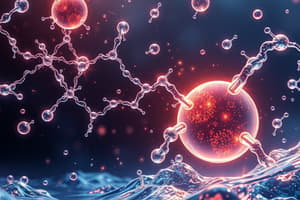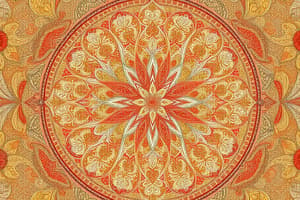Podcast
Questions and Answers
Atoms with the same number of protons but with different electrical charges _____.
Atoms with the same number of protons but with different electrical charges _____.
ions
In salt, what is the nature of the bond between sodium and chlorine?
In salt, what is the nature of the bond between sodium and chlorine?
Ionic
What is the result of the animated process?
What is the result of the animated process?
A positively charged sodium ion and a negatively charged chlorine ion.
An ionic bond involves _____.
An ionic bond involves _____.
What type of bond joins the carbon atom to each of the hydrogen atoms?
What type of bond joins the carbon atom to each of the hydrogen atoms?
What is the atomic number of an atom that has 6 protons, 6 neutrons, and 6 electrons?
What is the atomic number of an atom that has 6 protons, 6 neutrons, and 6 electrons?
Which of these refers to atoms with the same atomic number but different atomic masses?
Which of these refers to atoms with the same atomic number but different atomic masses?
Fluorine's atomic number is 9 and its atomic mass is 19. How many neutrons does fluorine have?
Fluorine's atomic number is 9 and its atomic mass is 19. How many neutrons does fluorine have?
An uncharged atom of boron has an atomic number of 5 and an atomic mass of 11. How many protons does boron have?
An uncharged atom of boron has an atomic number of 5 and an atomic mass of 11. How many protons does boron have?
What is the term for an atom that is electrically charged as a result of gaining or losing electrons?
What is the term for an atom that is electrically charged as a result of gaining or losing electrons?
The brackets are indicating a(n) _____ bond.
The brackets are indicating a(n) _____ bond.
What name is given to the bond between water molecules?
What name is given to the bond between water molecules?
Each water molecule is joined to _____ other water molecules by ____ bonds.
Each water molecule is joined to _____ other water molecules by ____ bonds.
The unequal sharing of electrons within a water molecule makes the water molecule _____.
The unequal sharing of electrons within a water molecule makes the water molecule _____.
The tendency of an atom to pull electrons toward itself is referred to as its _____.
The tendency of an atom to pull electrons toward itself is referred to as its _____.
In this molecule, what type of bond is found between the oxygen and hydrogens?
In this molecule, what type of bond is found between the oxygen and hydrogens?
Which of these bonds is weakest?
Which of these bonds is weakest?
Why isn't this insect drowning?
Why isn't this insect drowning?
A phrase that applies to covalent bonding and not other kinds of bonds is...
A phrase that applies to covalent bonding and not other kinds of bonds is...
The term for a solution with a low pH number, such as lemon juice or vinegar, is...
The term for a solution with a low pH number, such as lemon juice or vinegar, is...
The term for a solution that has an equal concentration of H+ and OH- is...
The term for a solution that has an equal concentration of H+ and OH- is...
The term for a solution with a high pH number, such as ammonia or bleach, is...
The term for a solution with a high pH number, such as ammonia or bleach, is...
An acid is a compound that donates ____ to a solution.
An acid is a compound that donates ____ to a solution.
The higher the pH number, the higher the concentration of _____ in a solution.
The higher the pH number, the higher the concentration of _____ in a solution.
A substance that accepts H+ when they are in excess and donates H+ when their concentration drops is called a(n) ____.
A substance that accepts H+ when they are in excess and donates H+ when their concentration drops is called a(n) ____.
The tendency of water molecules to stick together is called __________.
The tendency of water molecules to stick together is called __________.
What is the pH inside most living cells?
What is the pH inside most living cells?
Silicon has an atomic number of 14 and a mass number of 28. How many neutrons are found in silicon?
Silicon has an atomic number of 14 and a mass number of 28. How many neutrons are found in silicon?
Carbon-12 and carbon-13 are different in the number of their _____
Carbon-12 and carbon-13 are different in the number of their _____
Four elements combine to make about 96% of the mass of the human body. Which of the following elements is one of the four?
Four elements combine to make about 96% of the mass of the human body. Which of the following elements is one of the four?
An atom's ________ are found in its nucleus.
An atom's ________ are found in its nucleus.
The four most common elements found in living organisms are ________.
The four most common elements found in living organisms are ________.
The bond between oppositely charged ions is a(n) ________ bond.
The bond between oppositely charged ions is a(n) ________ bond.
What name is given to bonds that involve the sharing of electrons?
What name is given to bonds that involve the sharing of electrons?
Adjacent water molecules are joined by ________ bonds.
Adjacent water molecules are joined by ________ bonds.
Sweating cools your body by ________.
Sweating cools your body by ________.
As water freezes, ________.
As water freezes, ________.
Flashcards are hidden until you start studying
Study Notes
Atomic Structure and Ions
- Atoms with the same number of protons but different charges are known as ions.
- An atom’s atomic number is defined by its number of protons; for example, an atom with 6 protons has an atomic number of 6.
- Isotopes are atoms with the same atomic number but different atomic masses, indicating a variation in neutron count.
Ionic and Covalent Bonds
- An ionic bond is an attraction between ions with opposite charges, resulting in the formation of ionic compounds such as salt (sodium and chlorine).
- A water molecule demonstrates polar covalent bonding, characterized by unequal electron sharing between oxygen and hydrogen atoms.
- Carbon atoms form single (nonpolar) covalent bonds with hydrogen atoms in organic compounds.
Water Molecule Interactions
- Water molecules are connected by hydrogen bonds, with each water molecule forming bonds with four others.
- The tendency of water molecules to stick together is referred to as cohesion, which contributes to surface tension.
Acidity, Neutrality, and Basicity
- Solutions with low pH values (like lemon juice) are termed acidic, while those with high pH values (like ammonia) are basic.
- A solution with an equal concentration of hydroxide (OH-) and hydrogen (H+) ions is neutral, common in biological systems.
- Buffers are substances that help maintain pH by absorbing excess H+ or releasing them when their concentration drops.
Water and Life
- The pH inside most living cells is around 7, maintaining homeostasis.
- Water's unique properties, such as high specific heat and evaporative cooling, help regulate temperature in organisms.
Elements in Living Organisms
- Four primary elements (carbon, oxygen, nitrogen, hydrogen) constitute about 96% of body mass.
- Silicon, with an atomic number of 14, has 14 neutrons when its mass number is 28.
Chemical Bonding and Properties
- Covalent bonds involve the sharing of electrons, such as in water, while ionic bonds involve the transfer of electrons between atoms.
- The strength of bonds varies, with covalent bonds generally stronger than hydrogen bonds.
Summary of Key Terms
- Ion: A charged atom due to gain or loss of electrons.
- Isotope: Atoms with the same atomic number but different neutron counts.
- Cohesion: Water molecules' tendency to stick together.
- Buffer: A substance that stabilizes pH by managing H+ concentrations.
Studying That Suits You
Use AI to generate personalized quizzes and flashcards to suit your learning preferences.




